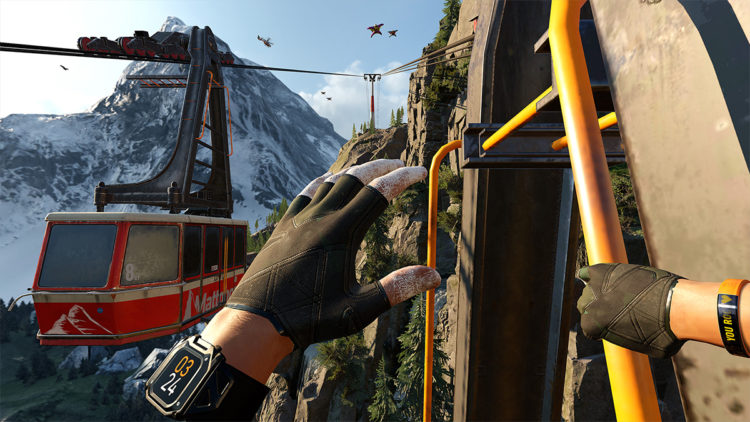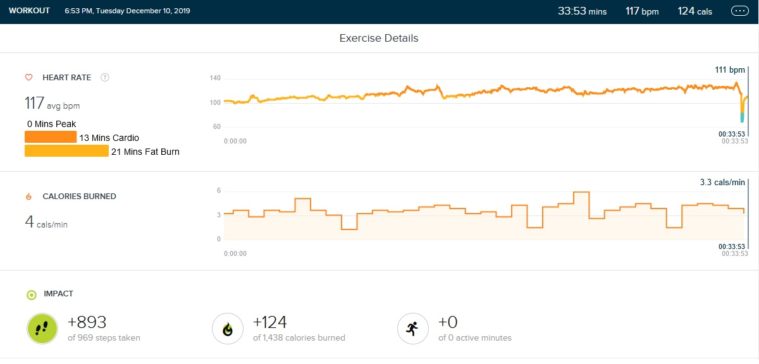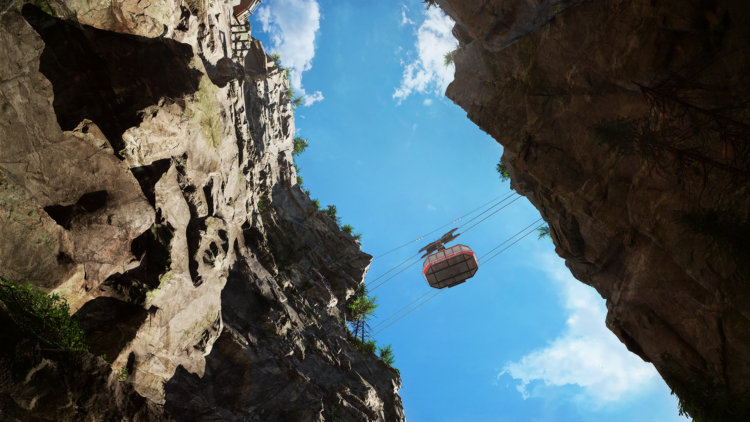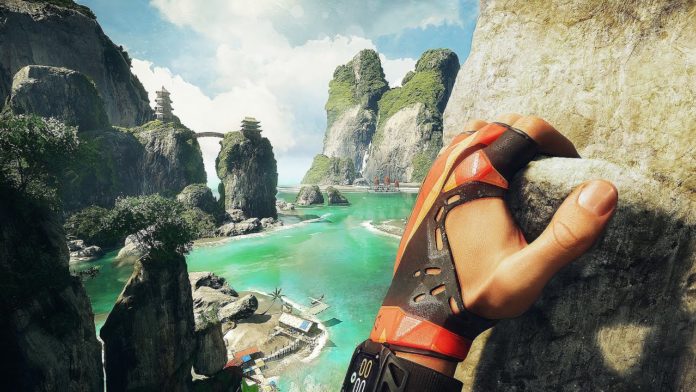My first experience with Crytek’s adrenaline-fuelled free solo simulator The Climb came way back in July 2017. As someone who is terrified of heights, watching Youtubers scream and yelp as they attempted, and failed to traverse a treacherous cliff face, plummeting to their virtual deaths was both thrilling and intriguing and was one of the motivating factors in my decision to fork out a couple grand for a new top-end PC and an Oculus Rift headset. I bought the game as soon as I got my headset, and it’s remained a favorite ever since.
The Climb might be one of the oldest VR titles, but it retains its contemporary relevance, as the game has now launched for standalone mobile VR, on the Oculus Quest.
Considering it launched in 2016 as an Xbox controller only game, with Oculus Touch support coming months later, to now supporting true, untethered virtual reality on a standalone headset, The Climb’s evolution mirrors that of virtual reality in general. It’s a fantastic feeling to be able to take this game over to my friend’s houses, set it up in the garden, and marvel at how far we’ve come in a few short years!
For whatever reason here at VRFI we never got around to reviewing the PC version of this game This review will, therefore, cover both the PC and Quest versions, and I’ll compare and contrast them towards the end of the review.
Channel your inner Alex Honnold
As its title suggests The Climb is a free solo climbing simulator that allows you to experience something of what it must have been like for Alex Honnold to scale El Capitan, equipped only with some gloves and a chalk bag. There is an unavoidable limitation of course, whilst you can hold your arms above your head and imagine you’re hanging on by your fingertips to a tiny outcrop hundreds of meters above the ground, gravity does not allow us to do the same with our legs. Therefore the game acts as if you’re just a pair of hands, dangling over a precipice. True climbing obviously involves your legs and feet a lot more, so virtual climbing isn’t going to give you skills that translate to the real thing. However, when it comes to the one facet of climbing that is most essential to reproduce, that stomach-churning sensation of peering down into the abyss is absolutely captured with a frankly alarming sense of realism. If you have a fear of heights this might be the scariest game you ever play. In a good way!

Preparation
I spent a couple hours replaying this on my PC prior to the Quest launch, then played on the Quest to compare the port. Gameplay is identical on both so the fitness test I played on PC, just because the graphics are so damn nice. This is a forward-facing game only where you will mostly be standing in place so ideal if you don’t have the most space. Ceiling height and low-level fans and lighting could be an issue though so make sure you have room to raise your arms and extend them. I wore a headband but really didn’t sweat much playing this, at least not on my head. Interestingly this is the first game to ever make my hands sweat, a testament to how real the feeling of vertigo the game can induce. You may want to, therefore, ensure you’re using the hand-straps just in case the controllers get a bit slippery.
I used my Fitbit charge 2 to record the session and completed as many climbs as I could in just over 30 minutes. I managed 5!
Intensity 7/10

- Calories burned: 124
- Calories per minute: 4
- Average heart rate: 117
- Max heart rate: 135
- Steps:893
- Active Minutes: 34
I did wrestle with the idea of not including a Fitbit test at all as I don’t think it’s the best way to assess the beneficial qualities of this game. These numbers might not look impressive, but they don’t tell the whole story. The Climb might not be the best aerobic workout, but it’s a great muscular endurance one for your shoulders. Furthermore, the game functions equally well as a mindfulness tool. I found that after playing I felt calmer and more relaxed.
There’s something about the beauty of the locations, the intensity felt when scaling great heights and the absolute focus required to safely navigate to the top of each game world that just left me feeling refreshed and cleansed in some way. I have tried several meditation apps in my time and The Climb beats them all in this regard. This actually makes a lot of sense. We are all familiar with the action of climbing a mountain being a universal metaphor for overcoming obstacles that life throws at us. Furthermore, in almost every culture the visualization of somebody sitting alone on a mountain top evokes feelings of clarity, inner peace, even spirituality. The Climb succeeds superbly in replicating both the sense of satisfaction of having accomplished something worthwhile and also that feeling of being connected to nature and the universe.
It’s a wonderful experience that isn’t done justice when just looking at Fitbit statistics like heart rate and calories burned alone. I decided to include the Fitbit chart as it does accurately reflect the game’s limited ability to work your cardiovascular system to a great degree. But neither does Yoga or Tai Chi and yet the health benefits of both are incredibly well attested.
The game might serve better as a warm-up or cool-down to your main workout but its absolutely worthwhile.
Arms 8/10
To be more precise, it’s not your arms, but your shoulders that will definitely feel the burn playing this game. I would imagine that for people who struggle with arm burn out whilst carrying bags of shopping or hanging up clothes this game would certainly help build up some muscular endurance, and maybe improve rotation of movement and flexibility.
I was curious as to whether wrist weights would be a good idea for this game to increase the muscular endurance load. Not owning them myself I took to reading Reddit and other forums. Recommendations were mixed, some using them, others warning against them because of the potentially unnatural range of motions you might need in the game. I would probably advise caution. Unless you’re already a fairly advanced fitness enthusiast I’d say lift weights if you want to increase strength and enjoy the game for what it is.
Legs 3/10
This game is played standing, and there will be times when you need to stand on tiptoes to reach a high ledge, but other than that it’s all hand and arm movements only. It’s this lack of leg involvement that really prevents the game from getting your heart rate up.
Core and Balance 7/10
In contrast to legs, I feel your core and balance are worked pretty well in this game. You need to commit and throw yourself into the experience of course, but if you do you’ll be reaching up high, extending your arms out wide and often having to really stretch to grab elusive handholds just out of reach. If you seek to actively climb the most demanding routes and explore for hidden cameras and objects you’ll be clambering all over the mountainsides so lots of opportunity for stretching and extending. Of course, the necessity for your movements to be executed with precision to avoid falling to your certain death helps improve your balance too!
Time Perception 8/10
The game is a lot of fun but also fatiguing. When you first start out your shoulders will likely burn after a few minutes. Furthermore, if you are sensitive to heights some sections of climbs can be quite rattling to the old nerves and like a scary VR horror, it can quickly deplete you. I find the level of focus it requires to get around safely, especially the harder climbs can be mentally taxing. I’ve usually had enough after thirty minutes and breath a sigh of relief climbing safely up to my final platform. That said I’m often happy to stand or even sit and chill for ten minutes or so at the top, as the payoff for your climb is usually a spectacular view, and it’s nice to linger a while and soak it in.
Replayability 9/10
There are 3 game environments each with three climbs and two boulder sections, plus an unlimited practice wall. All the climbs are highly replayable if you enjoy the process. The PC version has an additional environment, The North, with 3 levels, which are superb, and two extra boulder sections. Both the PC and Quest versions feature tons of unlockables, such as gloves, watches, reward boxes, etc. You can complete all the climbs fairly quickly, but it will take a long time to unlock all the achievements.

Fitness Scalability 7/10
The game has a leisurely tourist mode, a main game mode that features sweating hands and the need for chalking, and a competitive race mode. In the race mode, you race against the best saved times, either for yourself, friends, or others on the leaderboard. The race mode can be much faster paced than normal and you could conceivably get your heart rate up a bit higher than my playtest. But ultimately the absence of any leg movement or active punch/slice mechanics means it will never get close to Beat Saber or Thrill of the Fight for intensity.
Lack of Nausea 8/10
Locomotion through the game world is driven by your own arm movements. This feels incredibly natural so you shouldn’t feel the disconnect you feel when using smooth locomotion. Sickness is usually induced by your game character moving whilst you are physically standing still. In The Climb, your physical movements are in perfect synchronicity with your virtual movements so nausea shouldn’t be an issue for most people. Having your stomach churn from looking down is a different matter though!
Social Competition 8/10
There is no direct PVP but you can compete against friends, and indeed yourself, by racing against a person’s best time. You will see their ghost hands in the game and it’s a race to climb to the top. I tried to race the current leader for the Bay easy climb on PC. I completed it as fast as I could in 2 minutes flat, the record holder did it in 30 seconds! I don’t yet know how that is even possible but it shows me I still have a lot to explore and learn in this game!
Jump to 6:55 in the video below to watch BMF race Nathie for an idea of how the race mode works.
PC versus Quest
The good news for Oculus users is that The Climb is cross-buy enabled meaning if you buy for either platform you get the other for free. Given that it’s an Oculus exclusive this means it’s not possible to buy one without getting the other, so you don’t need to choose which version to buy.
The Quest port is very well done indeed. Obviously, it is a visual downgrade, a quite a considerable one if you own a Rift S with a GPU capable of running at the highest settings with supersampling. Even now, three years on from its original release the PC version is possibly in the top 5 best looking VR games, period. I’d not played it for a few months before this review and realized this was the first time I’d used my Rift S to play it. The upgrade over my old Rift CV1 was dramatic. It is a stunning game on PC, easily comparable to Stormland and Asgard’s Wrath in terms of visual fidelity.
Of course, the Quest cannot capture that, the textures are greatly reduced, details stripped down, and the backgrounds no longer interactive. Nonetheless, it retains all of the sense of scale and presence of the PC version, and the gameplay feels identical. I had no problems with the tracking and it runs smoothly. Compared to other Quest game it’s graphically stellar throughout. If you are a Quest owner considering investing in a PC to take advantage of Link this is one game you’ll definitely want to try again on PC.
I do love the freedom of wireless on the Quest, and it’s awesome to be able to take it to friends to show the game off but the PC version is definitely superior in style if not substance.
There’s more content too, the North expansion not being included on the Quest release. I did reach out to Crytek to see if they intended to release that as an update or DLC in the future but as of this writing, I’ve not had a reply. Even so, it’s absolutely recommended on Quest too, for a truly unique climbing experience.
VRFI Fit Score 7.5
VRFI Game Score: 9
I have always had a soft spot for The Climb and consider it one of the essential VR titles to try. The PC version might be ancient but it still stacks up visually against any current game and I consider it to be one of the top 10 VR games I’ve ever played. The Quest version is stripped down but retains all of the playability and heart-stopping sense of fear for anyone who is sensitive to vertigo. As an exercise game, it’s probably better suited as a warm-up or cool-down activity than as a main course, although if you’re speed racing you’ll get your heart rate up more.
This is the kind of game that retains its charm and will be something you might come back to again and again over the months and years.
The Good
A compelling and rewarding climbing experience that offers both thrills and relaxation.
The sense of presence and immersion is real and intense.
The PC visuals are some of the best ever in VR.
Race mode adds social interaction and ups the challenge
On Quest, the game looks great and is likely to be extremely popular to show to friends.
The Bad
Not the most physically intense game out there.
Quest version lacks some of the PC content.
Without legs and a body virtual skills won’t translate to real climbing.
If you’re terrified of heights you probably won’t want to play this. It could help you overcome it though!
The Climb is exclusive to the Oculus platform for both Rift and Quest, and supports cross-buy. It is playable on other PC VR headsets via Revive.


